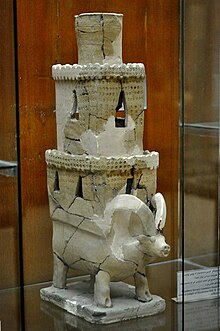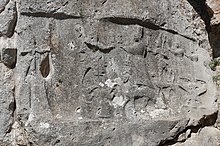Hurrian religion
The Hurrian religion is the polytheistic religion of the Hurrites , a Bronze Age people of the ancient Orient . Since these populated a wide area, there are differences, especially between the East Hurrites around Nuzi and Arrapḫa on the one hand and the West Hurrites in Syria and Anatolia on the other. From the 14th century BC The Hurrian religion exerted a strong influence on the Hittite religion , and in the important Hittite rock sanctuary Yazılıkaya from the 13th century BC. The Hurrian pantheon was depicted.
Lore
The sources regarding the Hurrian religion are manifold and regionally quite different. The oldest evidence comes from Urkeš and can be dated back to the 3rd millennium BC. To be dated.
The most extensive is the material from the Hittite archives of the Hittite capital Ḫattuša , whereby some of the texts are in Hurrian , but some have been translated into Hittite . From Ugarit , several Hurrian ritual texts have been preserved in the Ugaritic consonant script, most of which consist of lists of gods. Who wrote on Hurritic Mittanibrief of King Tushratta and treaties provide information about the Hurritic embossed religion of Mittanireiches . The archives of individual Syrian cities such as Emar , Mari and Alalaḫ also contain Hurrian texts. In the case of the Osthurritern the material is much less and only individual city pantheons can be deduced from the texts.
Belief in gods
The Hurrians worshiped a large number of gods from different cultures, especially Mesopotamia and Syria . In the course of time, many deities were assimilated to the Mesopotamian and Syrian, such as Šauška the Ištar from Nineveh, Teššub the weather god from Aleppo , Kušuḫ the moon god Sîn from Ḫarran and the sun god Šimige the Šamaš from Sippar. With these adjustments, they also took over the local wives, such as the Syrian Ḫebat as the wife of Teššub with the West Hurrians, Nikkal as the wife of the moon god and Aya as the wife of the sun god.
The main Hurrian god was the weather god Teššub . The goddess of love and war Šauška , the grain god Kumarbi , the moon god Kušuḫ and the sun god Šimige were worshiped by all Hurrites . Beiebat and her son Sarruma , who are of Syrian origin, were worshiped only by the West Hurrians . Other important deities were the mother goddesses Ḫudena Ḫudellura , the Syrian oath goddess Išḫara and Kubaba as well as the originally Mesopotamian god of wisdom Ea (Eya-šarri) and the god of the dead Uğur .
The deities, at least among the West Hurrians, were divided into a male and a female series, as is clear from the kaluti lists from Ḫattuša. The male series ( enna turroḫena "male gods") is preceded by Teššub in various manifestations and the female series ( enna aštoḫena "female goddesses") Ḫebat with her children. The order of the gods and goddesses is not completely fixed, but lists of gods from Ḫattuša and Ugarit show clear similarities. The occurrence of collectives of gods, especially the father deities ( enna attenevena ), is common to these lists of gods. No such lists of gods are known from the East Hurrians.
Dyads are also typical of the Hurrites, i.e. double deities that were worshiped together in the cult, so Ḫebat and her son Šarruma formed the dyad Ḫebat-Šarruma.
Myths
The Hurrites had developed their myths literarily, whereby Mesopotamian and Syrian influences are clear. The most important gods myths belong to the Kumarbi cycle, which has a parallel in the Ugaritic Baal cycle, which tells how the Ugaritic weather god Baal became the main god. Similarly, the Kumarbi cycle deals with how Teššub seized and consolidated power, which is why it is also suggested to speak better of a Teššub cycle. This begins with the myth of kingship in heaven , where the succession of the first kings of the gods - Alalu, Anu and Kumarbi - and their struggles are briefly described, and then deals with the conception and birth of Teššub. The following myths tell how Kumarbi, overthrown by Teššub, witnessed ever stronger and more powerful opponents in order to destroy Teššub. These include Ušḫuni ("silver"), the water dragon Ḫedammu and finally the rock monster Ullikummi . The myth of the patron god, who was temporarily employed as the king of the gods but neglected the sacrifice of gods, should also belong to this cycle of myths. Unfortunately, most of the myths have only survived in fragments.
In addition to the myths, there are also stories and legends, such as the story of Appu and his two sons "Bad" and "Righteous" and the story of the sun god and the cow. In both legends, the sun god appears as a young man. Hero epics belong here only marginally.
cosmology
The Hurrians deified earth and sky ( eše ḫavurne ), but these were not regarded as anthropomorphic deities. They have rested since ancient times on the world giant Ubelluri , who also witnessed how earth and sky were cut apart with a copper sickle. In the illustration by Yazılıkaya, two bull people standing on earth support the sky.
The dead go to the underworld, which is ruled by the goddess Allani . The “lower deities” ( enna turena ) also live here. The Hurrites sacrificed to the chthonic powers by digging sacrificial pits ( abi ) in the earth. The ancestral deities also received offerings.
Cults
The Hurrians knew sanctuaries and temples where they worshiped their deities. What is striking is the deification of cult objects, such as the incense bowl or sacrificial table, but also the attributes of gods, such as the weapon Teššub or the bed Ḫebats. Images of gods were cleansed and anointed and carried around. The Hittite išuwa festival offers a detailed compilation of West Hurrian rituals - mixed with Luwian rituals .
According to the epoch and religion, magical acts were an integral part of cult rituals. Purification rituals in particular played an important role. The magical practices are often very similar to the Mesopotamian, this also applies to the oracle being . The liver show was of great importance .
See also
Individual evidence
- ^ Piotr Taracha: Religions of Second Millennium Anatolia , (2009), p. 127
- ^ Piotr Taracha: Religions of Second Millennium Anatolia , (2009), p. 118
- ^ Piotr Taracha: Religions of Second Millennium Anatolia . (2009), p. 92
literature
- Emmanuel Laroche : Teššub, Ḫebat et leur cour. In: Journal of Cuneiform Studies . Vol. 2, No. 2, 1948, pp. 113-136, doi : 10.2307 / 1359380 .
- Piotr Taracha : Religions of Second Millennium Anatolia . Harrassowitz, Wiesbaden 2009, ISBN 978-3-447-05885-8
- Ilse Wegner: Hurrian lists of victims from Hittite festival descriptions. Part 2: Texts for Teššub, Ḫebat and other deities (= corpus of the Hurrian language monuments. Dept. 1: The texts from Boğazköy. Vol. 3). Multigrafica Editrice et al., Rome 2002, ISBN 88-87345-07-4 .

